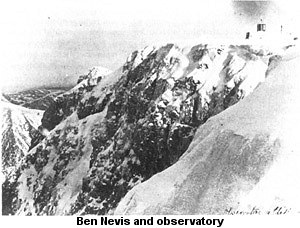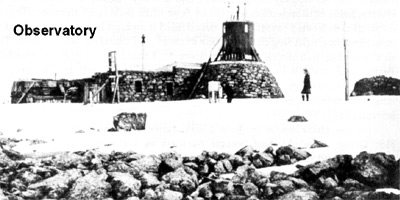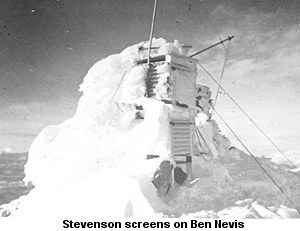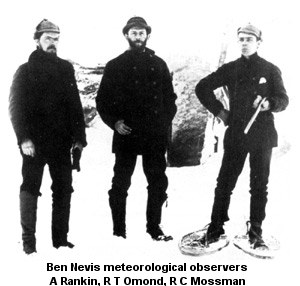
| Glasgow Digital Library | Voyage of the Scotia | BRUCE | PEOPLE | SHIP | ANTARCTIC | INDEX |
|---|

In 1893 Bruce was asked by the eminent scientist Alexander Buchan to be a member of the staff of the Ben Nevis Observatory. He saw this as a great opportunity to sample Arctic conditions in Scotland. 'I shall thus, in a miniature way, be experiencing the rigours of a polar winter and trust to be more than ever fitted for the duties of an Antarctic meteorologist and explorer.'
The Ben Nevis Observatory had been suggested in 1877 and plans were drawn up by Thomas Stevenson the lighthouse engineer (father of Robert Louis Stevenson and inventor of the 'Stevenson screen'). Plans were also made for an observatory on the top of Ben Macdui.
In 1881 Clement Wragge offered his services to make observations on Ben Nevis between June and October. This involved climbing the Ben every day, in all weather, and making various observations on the way to the top. He repeated this in 1882 and 1883, when he moved to Queensland in Australia as a meteorologist.
The observatory on Ben Nevis was opened in 1883, mainly paid for by public subscription. The best publicity in the national press at the time was a long article on the exploits of Wragge.
The first superintendent of the observatory was R T Omond and his assistants were A Rankin and Robert C Mossman.

Hourly observations were now made on the Ben in summer and winter - often under the most appalling conditions. Supplies were brought up by pack ponies along the rough bridle path which had been constructed to the top. Observations were at times extremely difficult and the building was often covered by snow drifts resulting in the construction of a tower for access in winter.
The records for the Ben Nevis observatory are held in the meteorological office in Edinburgh and include requisitions for supplies. An order for a bottle of whisky was not fulfilled.
Bruce appears to have enjoyed his time on Ben Nevis. He not only took observations with the two other observers but plotted bird migrations and made a collection of insects - now in the museum in Edinburgh.
Bruce's time at the observatory was good training for his 1902 voyage to the Antarctic in the whaler Scotia. Two other members of his scientific team had spent time on Ben Nevis. Robert Mossman was one of the earliest observers and had written papers on his observations. He was highly regarded as one of Scotland's most eminent meteorologists. The other Scotia member was David Wilton, who was the Scotia zoologist.
Mossman was mainly responsible for the running of the meteorological station set up on the South Orkney Islands during the Scotia expedition which he manned for three years. When Scotia left in 1904 the Argentinian government took over the station and it continues to operate today - the British government had been offered the station.
Bruce was most upset by the closure of the Ben Nevis observatory in 1904: 'It is significant to note how the Argentine government willingly spent money on a scientific object such as this while nearer home we have the deplorable occurrence of an ignorant government closing the most important meteorological observatory in its country'.

Captain Scott - the Discovery expedition
Scott was given permission to stay at the observatory on Ben Nevis in the winter of 1900-01 to test Antarctic equipment. He was unable to go and First Lieutenant Royds (who sailed on Discovery) took his place.
Some quotes from the meteorological observers' log:
'Thermometer screen found torn off its hinges lying in the snow.'
'Rain gauge not found, probably blown over the North Cliff.'
'As soon as Mr Omond went outside the door of the new porch, he was lifted off his feet and blown backwards against Mr Rankin who was knocked over. No observations for two hours.'
'Notebook for observations torn in two and blown away.'
'08:00 - one of the cups of the anemometer was gone and could not be found. 09:00 - another cup gone.
'All around the observatory stones (thin packing stones) were blown out of the wall and several were found on the kitchen roof.'
'Solid blocks of ice flying around.'
One of the best known geologists at the end of the nineteenth century was Archibald Geikie. Bruce met him at the top of Ben Nevis. Bruce was lying in the snow counting and classifying insects brought by the 'updraft'. Geikie stayed the night at the top of the Ben (see Appendix 4).
When Bruce was on top of Ben Nevis he was sent some skis by William Burn-Murdoch - probably the first in Scotland. Bruce was one of the first British polar explorers to become proficient at skiing. On one occasion this almost proved fatal when he just managed to save himself from plunging over the cliffs of Ben Nevis. Bruce was the first President of the Scottish Ski Club.

Snow on Ben Nevis
Ben Nevis has an average snow cover of 215 days a year. At times the weather is similar to the Arctic and Antarctic.
| Glasgow Digital Library | Voyage of the Scotia | BRUCE | PEOPLE | SHIP | ANTARCTIC | INDEX |
|---|